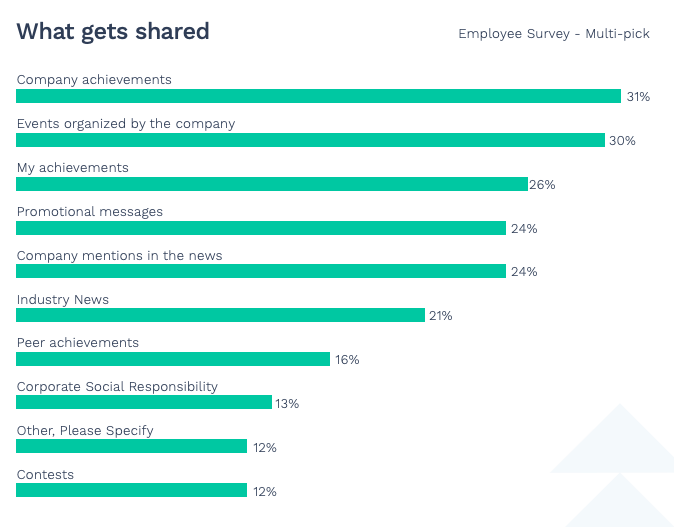Do you want to improve your ROI from paid ads on social media?
Paid social media is fickle at times. The endless options for ad targeting are helpful in getting your message to the right audience. However, paid social media can get expensive and it’s uphill battle to stand out as well. Not to mention ad fatigue. That elusive flow of consistent engagement is hard to create but it’s not impossible.
If you want to go fast, go alone. If you want to go far, go together.
Paid social media on its own can only get you so far. You may be able to build up momentum, pouring out dollars and getting views. But clicks on your paid social ads don’t matter nearly as much as conversion. It’s on this front — real engagement that turns into conversion — that determines successful paid campaigns from unsuccessful ones.
What if building a foundation of employee advocacy can increase the impact of paid social media ads?
Mixing paid social media and employee advocacy can seem like it’s counterproductive but consider the benefits. Combining paid social media and employee advocacy can help determine what content or topics resonate with your audience and capitalize on what’s already working in a less costly manner.
Here you’ll find the most benefit by focusing on what employee advocacy supports best: great content and an engaged community.
Social Media Advertising Cost: Paid Social Can Be Expensive
Have you ever seen headlines like “Man Loses $600k on Facebook Ads”?
There’s a reason for that. Social media ads can be effective to a certain degree; but they can also quickly become expensive. And, unless you have a close eye on your campaigns, the effectiveness of social media advertising is lower than organic efforts.
The bad news is that the cost of paid ads on social media is inflating, while their effectiveness is being diluted. Ad fatigue and banner blindness are real. Like the pot of gold at the end of the rainbow, you get to it only to realize it doesn’t exist.
- Facebook’s CTR for paid ads is just .89 percent, while the CPC is $1.68. Conversion rate is 9.11 percent.
- LinkedIn can be even more expensive: average CPC was over $4, while the average CTR is just 0.20 percent.
- Instagram is actually getting cheaper in terms of acquisition costs, but the CTR is even lower than Facebook.
These stats vary depending on your industry, of course, but you get the idea.
The good news is that it can still be ROI-positive and effective if managed well and if used in combination with other organic efforts.
You can make your own pot of gold if you stop chasing that rainbow and make a friction-free, clickable plan that delights both your employees and your target market.
Start by tapping into your in-house micro-marketing team: your own employees. Their organic connections are more powerful than even the best ad campaign. According to The Marketing Advisory Network, leads generated through employee advocacy convert 7x more frequently than other leads.
When combined with paid advertising, you extend the power of both channels.
How Does Employee Advocacy Fit In?
Nothing inspires brand loyalty like hearing a peer talk about a product or service they used and loved. Word-of-mouth and human connections are much more powerful than social media ads.
If a friendly stranger on the train recommends a restaurant, it means more than all the Yelp reviews I could possibly find.
Bringing this human aspect into social media marketing isn’t new. It’s just simply good marketing. It means using authentic human connections to generate qualified website traffic, convert leads and save on paid media.
Providing your employees with quality, shareable content, and developing individualized calendars for regular, consistent posting will keep things engaging. The nice thing about paid social ads is that they are social: their reach can be amplified with high engagement.
That high engagement can start with your employees. Invest in streamlining and organizing the content and advocacy process first, then layer in paid advertising.
Here are some simple steps to get ahead of an actual paid social campaign:
- Write down your goals. Your initial goals will determine the type of content you develop and where you focus your efforts. Is it to generate leads? Build brand awareness? Attract more qualified traffic to your website? Or, is it to nurture current opportunities?
- Define your look, feel and tone. As much as possible, this should be a bottom-up exercise. Inspire organic connections by helping employees find their authentic voice online. Everyone brings their personal tone, make sure it feels like it’s coming from humans, not a machine.
- Make a content calendar. Based on your goals, create a content calendar that can run alongside your paid campaign. Be sure to mark where and when content will be used to form the basis of paid ads.
- Encourage internal engagement. Run workplace competitions and acknowledgments for engagement, posts, even profile quality.
- Check your personality. Be nice, funny, interesting, attractive, you know, all those things high-schoolers value, and you’re good to go.
- Look at the data. Are you measuring what is working and what is not? Track your paid social media campaigns and measure effectiveness. Success is defined by the KPIs you set such as CTR, lead conversions, or opportunities created. Consistently look at the data and make weeks to boost performance.
Paid Media and Authentic Employee Advocacy: The Perfect Pair
By first creating content that your team will want to share, you’ve taken an important step in amplifying the reach of your paid campaigns.
Combining the two can translate into increased lead conversion, more qualified website traffic and saved marketing dollars through earned media.
Qualified website traffic
Getting your employees excited and engaged in strategic social media sharing is a huge step. Now streamline the process. Employees don’t want to share content that will quickly fizzle out. Instead, they want a steady stream of excellent content supported by diverse employee resources.
The content has to be relevant, visually-friendly and readily available daily for sharing. Based on our research on employee advocacy, content such as company achievements, events or personal achievements get the most shared.

To improve your website traffic, every social media post should provide value. The content itself has to address a specific customer problem or provide insightful information. More importantly, your employees should add their two cents and personalize their captions.
We’ve found that personalized social media captions generate 64% more engagement than posts that don’t.
Improve employee social sharing by offering social media workshops for refreshing LinkedIn profiles, social media 101, and social selling strategies. More engaged employees that are sharing means a better opportunity for your content to reach the right audience.
Increased lead conversion
To support this effort, every post should lead back to a thoughtfully designed landing page. It must give some level of instant gratification without asking the target to fill in lengthy contact information forms and wait days for a reply.
Previously, we promoted a webinar using both paid social media and employee advocacy. It was quite complimentary because they were both effective channels for driving webinar registrants. In fact, employee advocacy actually drove a registrant which later became a customer.
Recommended Content: How I Closed a $20K Deal from One Social Share
Make sure you are meeting an actual need and keeping the connection warm; as human as possible, in other words.
Value saved through earned media
Finally, you can set up that paid ad campaign. But you shouldn’t just leave it there. Instead, utilize tools that make it easy for employees to share within their own network. From there, you can track the engagement on these posts versus the straight-up paid campaign you’ve set up.
Chances are the engagement will be much higher on content shared by employees. There’s your saved value.
The organic connections your employees already have makes remarketing to already warm targets simpler. You are no longer an automaton to your ad fatigued social media market. You have a human face, and scrolling past that ad without paying attention to it feels like ignoring a friend.
Scale it or keep it simple. Either way, you’ll find ways to amplify your existing paid social strategy.
Employee Advocacy: The Litmus Test for Sponsored Content
Ongoing paid advertising campaigns can be budget-intensive to promote content. Without setting the right budget parameters, you can run the risk of overspending your budget and time.
Instead, use employee advocacy as a litmus test to see what content is gaining the most traction. Track what branded content is performing well and how much engagement it’s getting. If you’re seeing steady engagement or even an uptick then accelerate its performance by sponsoring it. Don’t forget to ask your employees for anecdotal insight into on working and what’s not. This approach can help reduce costs in the long-term.
If specific content is getting high engagement then why not sponsor it to boost its performance further?






